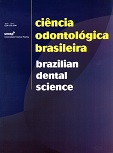Flexural strength of direct composites submitted to post-polymerization heat
DOI:
https://doi.org/10.14295/bds.2006.v9i3.202Abstract
The purpose of this study was to assess the effects of post-polymerization heat on the flexural strength of direct composites. Direct composite specimens (n=10), measuring 25×2×2 mm (Z-250 and P-60), were polymerized by 3 methods: (1) light-polymerized for 40 seconds, (2) (1) + post-polymerization in an oven at 120ºC for 20 minutes, and (3) (1) post-polymerization in an autoclave at 120ºC for 20 minutes. Specimens (n=10) of the indirect composite Artglass (control group) were polymerized in a UniXS oven. Specimens were stored in distilled water for 24 hours at 37ºC and then submitted to a flexural 3-point bending test with a universal testing machine. Flexural strength (MPa) data were analyzed by one-way ANOVA and Tukey´s multiple comparison test (α=.05). Results showed that (1) additional heat polymerization in an oven provided significantly (p<.05) higher flexural strengths (Z250: 158.85 MPa and P60: 147.10 MPa) than that of the Artglass resin (121.52 MPa); (2) with additional heat polymerization in an autoclave, these direct resins presented mean flexural strengths (Z250: 134.54 MPa and P60: 130.18 MPa) similar to that of Artglass (P>.05); (3) groups that were only light-polymerized (Z250: 124.75 MPa and P60: 128.96 MPa) were similar to Artglass (P>.05). When composites were only light-polymerized, they showed a flexural strength behavior similar to that of the indirect composite Artglass. The post-polymerization heat do not enhanced the resistance of the Filtek P60, but increased the strength of the Filtek Z250 when additional heat polymerization in a oven
Downloads
Downloads
Published
How to Cite
Issue
Section
License
Brazilian Dental Science uses the Creative Commons (CC-BY 4.0) license, thus preserving the integrity of articles in an open access environment. The journal allows the author to retain publishing rights without restrictions.
=================




























